Globalisation, Cultural Web Model and its Use in Practice: An Analysis
VerifiedAdded on 2024/07/24
|8
|1433
|80
Essay
AI Summary
This essay delves into an analysis of globalisation and the cultural web model through e-learning activities, drawing upon insights from Week 2 and Week 3 learning materials. It examines Pankaj Ghemawat's perspective on globalisation, contrasting it with the notion of a 'flat world' using relevant data points such as cross-border phone calls and direct investment. The essay further explores the cultural web model and its practical application in call centers, emphasizing the importance of aligning cultural models with the nature of the business. It compares the effectiveness of the cultural web model with typology-based models for changing corporate culture, highlighting the benefits and drawbacks of each approach. The conclusion summarizes the key findings, emphasizing the complexities of globalisation and the value of the cultural web model in understanding organizational culture.
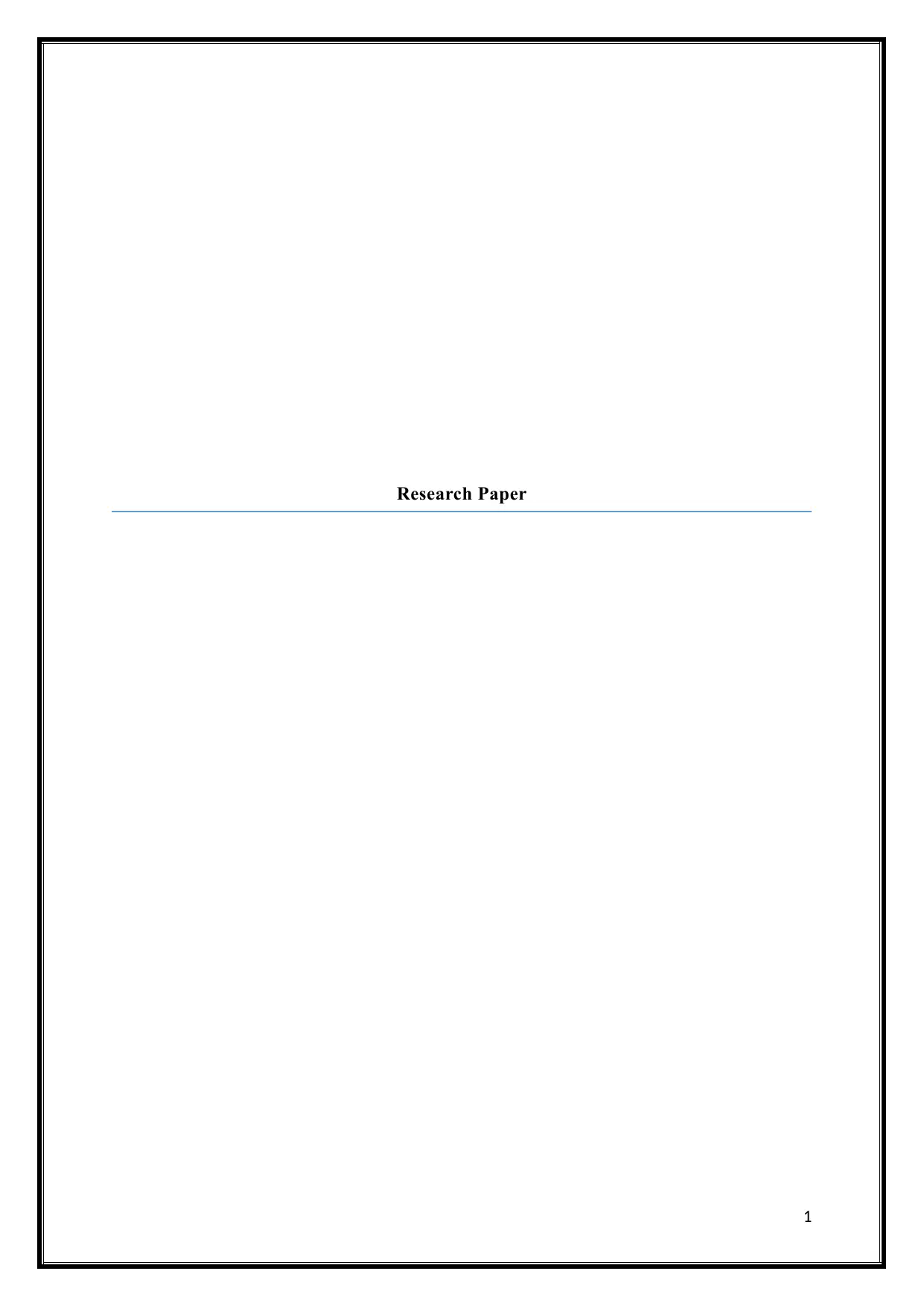
Research Paper
1
1
Paraphrase This Document
Need a fresh take? Get an instant paraphrase of this document with our AI Paraphraser
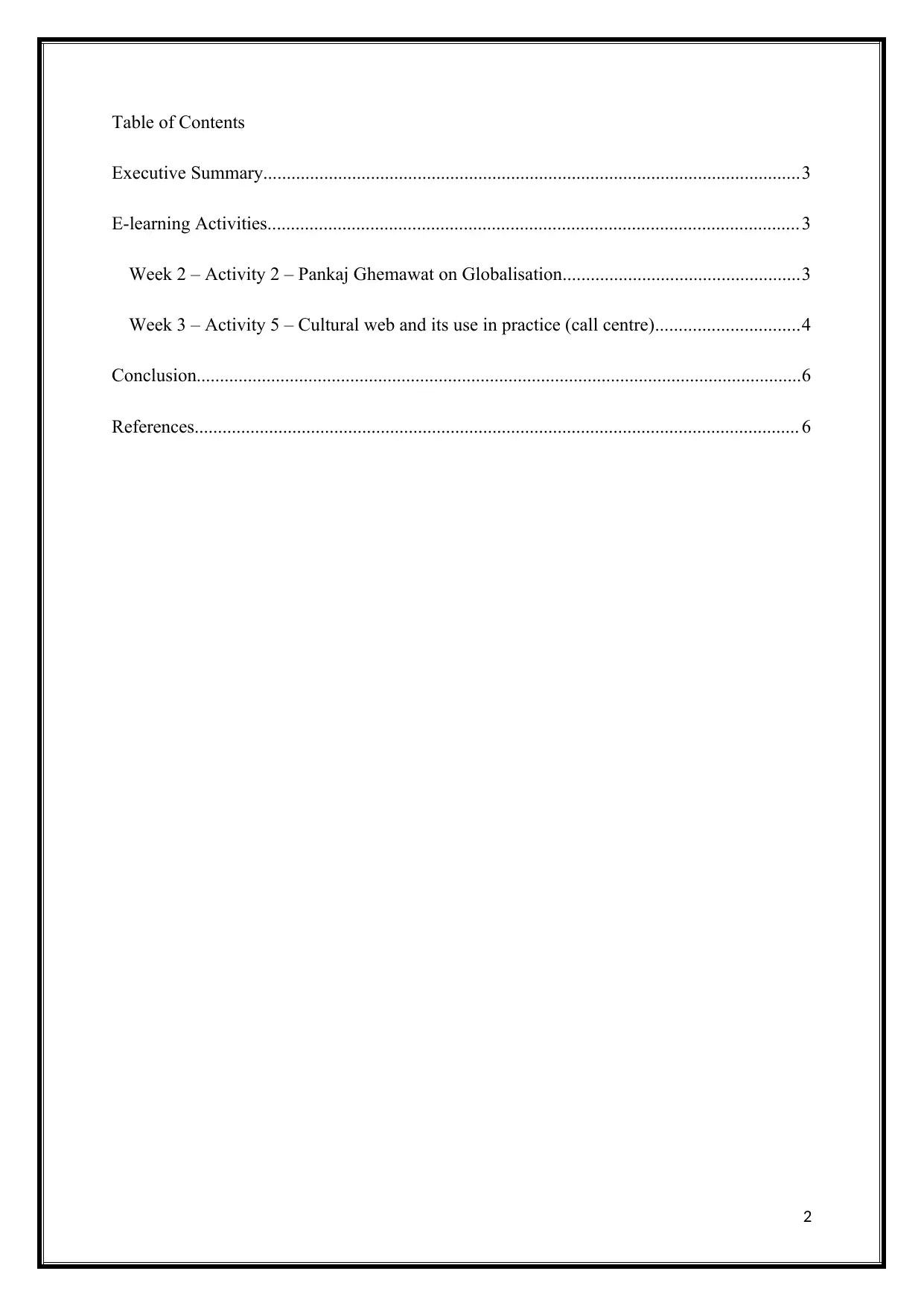
Table of Contents
Executive Summary...................................................................................................................3
E-learning Activities.................................................................................................................. 3
Week 2 – Activity 2 – Pankaj Ghemawat on Globalisation...................................................3
Week 3 – Activity 5 – Cultural web and its use in practice (call centre)...............................4
Conclusion..................................................................................................................................6
References.................................................................................................................................. 6
2
Executive Summary...................................................................................................................3
E-learning Activities.................................................................................................................. 3
Week 2 – Activity 2 – Pankaj Ghemawat on Globalisation...................................................3
Week 3 – Activity 5 – Cultural web and its use in practice (call centre)...............................4
Conclusion..................................................................................................................................6
References.................................................................................................................................. 6
2
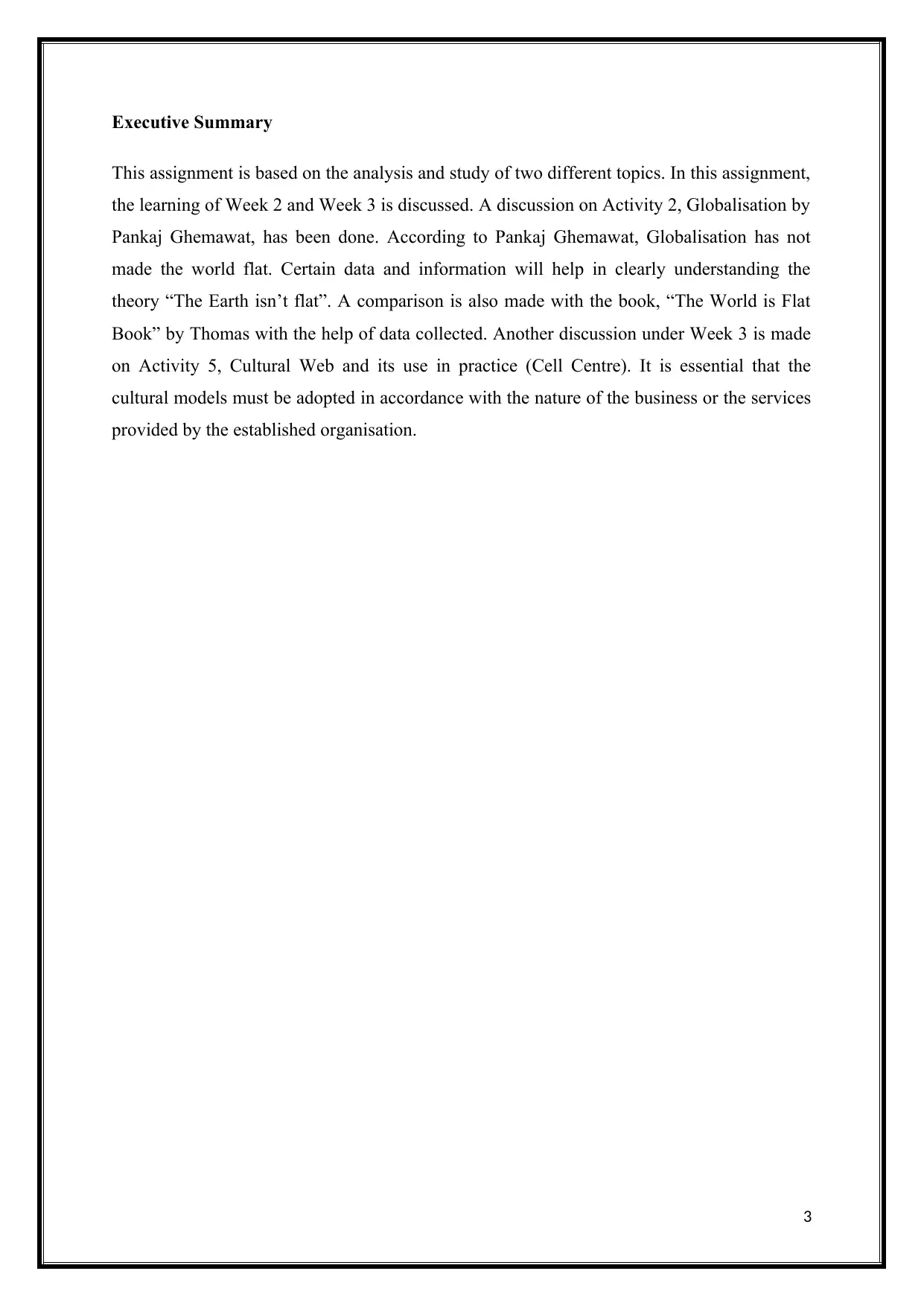
Executive Summary
This assignment is based on the analysis and study of two different topics. In this assignment,
the learning of Week 2 and Week 3 is discussed. A discussion on Activity 2, Globalisation by
Pankaj Ghemawat, has been done. According to Pankaj Ghemawat, Globalisation has not
made the world flat. Certain data and information will help in clearly understanding the
theory “The Earth isn’t flat”. A comparison is also made with the book, “The World is Flat
Book” by Thomas with the help of data collected. Another discussion under Week 3 is made
on Activity 5, Cultural Web and its use in practice (Cell Centre). It is essential that the
cultural models must be adopted in accordance with the nature of the business or the services
provided by the established organisation.
3
This assignment is based on the analysis and study of two different topics. In this assignment,
the learning of Week 2 and Week 3 is discussed. A discussion on Activity 2, Globalisation by
Pankaj Ghemawat, has been done. According to Pankaj Ghemawat, Globalisation has not
made the world flat. Certain data and information will help in clearly understanding the
theory “The Earth isn’t flat”. A comparison is also made with the book, “The World is Flat
Book” by Thomas with the help of data collected. Another discussion under Week 3 is made
on Activity 5, Cultural Web and its use in practice (Cell Centre). It is essential that the
cultural models must be adopted in accordance with the nature of the business or the services
provided by the established organisation.
3
⊘ This is a preview!⊘
Do you want full access?
Subscribe today to unlock all pages.

Trusted by 1+ million students worldwide
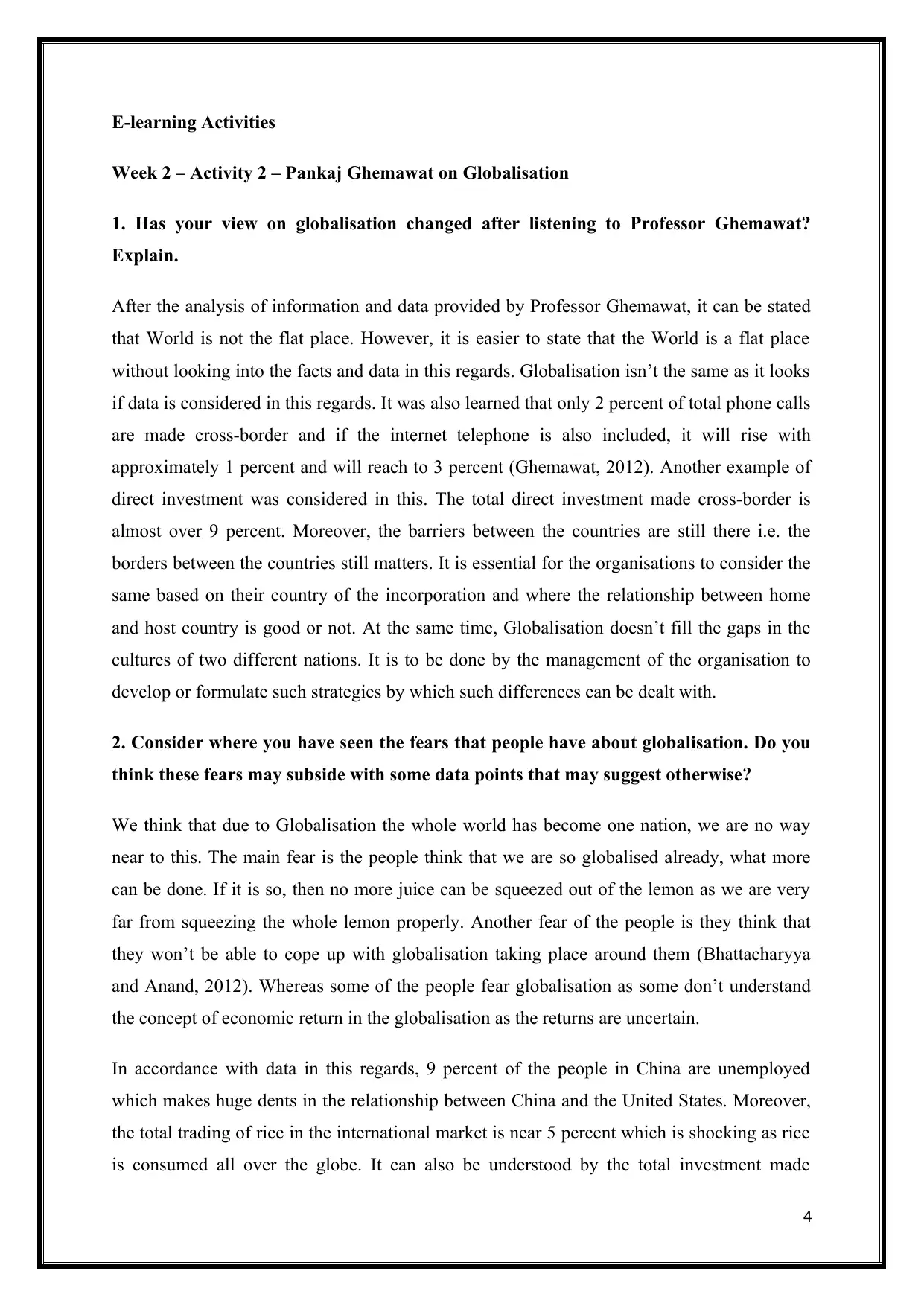
E-learning Activities
Week 2 – Activity 2 – Pankaj Ghemawat on Globalisation
1. Has your view on globalisation changed after listening to Professor Ghemawat?
Explain.
After the analysis of information and data provided by Professor Ghemawat, it can be stated
that World is not the flat place. However, it is easier to state that the World is a flat place
without looking into the facts and data in this regards. Globalisation isn’t the same as it looks
if data is considered in this regards. It was also learned that only 2 percent of total phone calls
are made cross-border and if the internet telephone is also included, it will rise with
approximately 1 percent and will reach to 3 percent (Ghemawat, 2012). Another example of
direct investment was considered in this. The total direct investment made cross-border is
almost over 9 percent. Moreover, the barriers between the countries are still there i.e. the
borders between the countries still matters. It is essential for the organisations to consider the
same based on their country of the incorporation and where the relationship between home
and host country is good or not. At the same time, Globalisation doesn’t fill the gaps in the
cultures of two different nations. It is to be done by the management of the organisation to
develop or formulate such strategies by which such differences can be dealt with.
2. Consider where you have seen the fears that people have about globalisation. Do you
think these fears may subside with some data points that may suggest otherwise?
We think that due to Globalisation the whole world has become one nation, we are no way
near to this. The main fear is the people think that we are so globalised already, what more
can be done. If it is so, then no more juice can be squeezed out of the lemon as we are very
far from squeezing the whole lemon properly. Another fear of the people is they think that
they won’t be able to cope up with globalisation taking place around them (Bhattacharyya
and Anand, 2012). Whereas some of the people fear globalisation as some don’t understand
the concept of economic return in the globalisation as the returns are uncertain.
In accordance with data in this regards, 9 percent of the people in China are unemployed
which makes huge dents in the relationship between China and the United States. Moreover,
the total trading of rice in the international market is near 5 percent which is shocking as rice
is consumed all over the globe. It can also be understood by the total investment made
4
Week 2 – Activity 2 – Pankaj Ghemawat on Globalisation
1. Has your view on globalisation changed after listening to Professor Ghemawat?
Explain.
After the analysis of information and data provided by Professor Ghemawat, it can be stated
that World is not the flat place. However, it is easier to state that the World is a flat place
without looking into the facts and data in this regards. Globalisation isn’t the same as it looks
if data is considered in this regards. It was also learned that only 2 percent of total phone calls
are made cross-border and if the internet telephone is also included, it will rise with
approximately 1 percent and will reach to 3 percent (Ghemawat, 2012). Another example of
direct investment was considered in this. The total direct investment made cross-border is
almost over 9 percent. Moreover, the barriers between the countries are still there i.e. the
borders between the countries still matters. It is essential for the organisations to consider the
same based on their country of the incorporation and where the relationship between home
and host country is good or not. At the same time, Globalisation doesn’t fill the gaps in the
cultures of two different nations. It is to be done by the management of the organisation to
develop or formulate such strategies by which such differences can be dealt with.
2. Consider where you have seen the fears that people have about globalisation. Do you
think these fears may subside with some data points that may suggest otherwise?
We think that due to Globalisation the whole world has become one nation, we are no way
near to this. The main fear is the people think that we are so globalised already, what more
can be done. If it is so, then no more juice can be squeezed out of the lemon as we are very
far from squeezing the whole lemon properly. Another fear of the people is they think that
they won’t be able to cope up with globalisation taking place around them (Bhattacharyya
and Anand, 2012). Whereas some of the people fear globalisation as some don’t understand
the concept of economic return in the globalisation as the returns are uncertain.
In accordance with data in this regards, 9 percent of the people in China are unemployed
which makes huge dents in the relationship between China and the United States. Moreover,
the total trading of rice in the international market is near 5 percent which is shocking as rice
is consumed all over the globe. It can also be understood by the total investment made
4
Paraphrase This Document
Need a fresh take? Get an instant paraphrase of this document with our AI Paraphraser
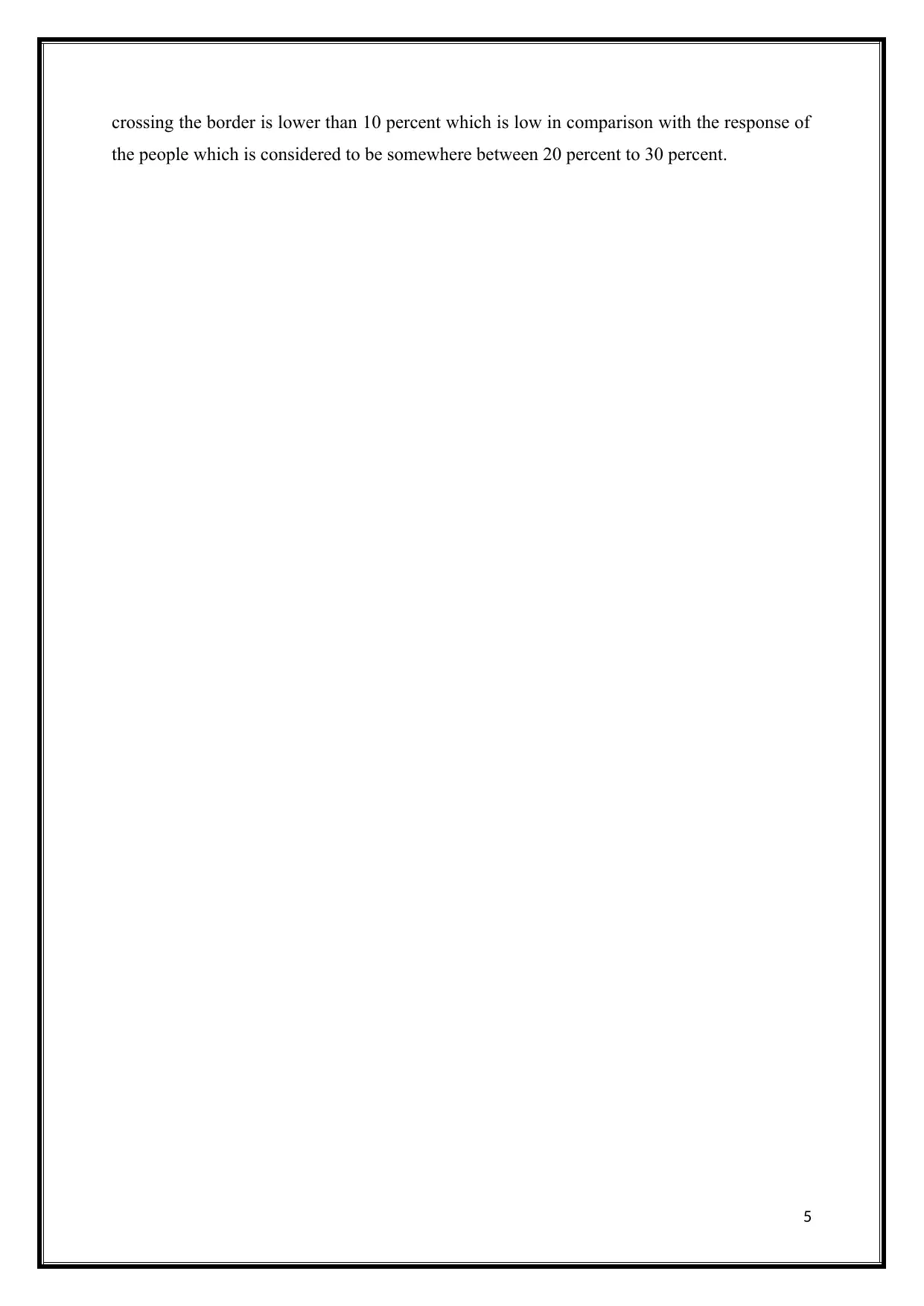
crossing the border is lower than 10 percent which is low in comparison with the response of
the people which is considered to be somewhere between 20 percent to 30 percent.
5
the people which is considered to be somewhere between 20 percent to 30 percent.
5
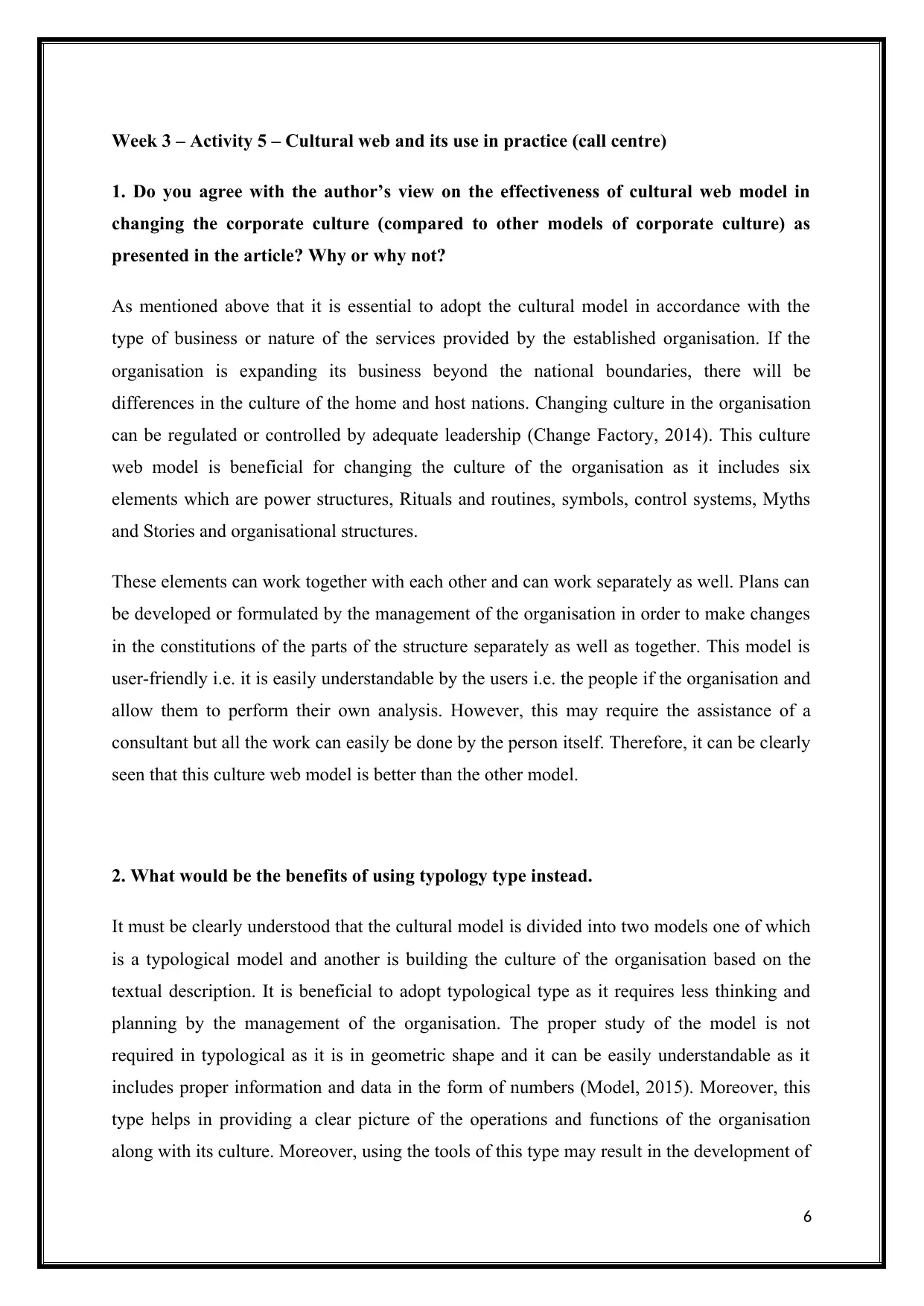
Week 3 – Activity 5 – Cultural web and its use in practice (call centre)
1. Do you agree with the author’s view on the effectiveness of cultural web model in
changing the corporate culture (compared to other models of corporate culture) as
presented in the article? Why or why not?
As mentioned above that it is essential to adopt the cultural model in accordance with the
type of business or nature of the services provided by the established organisation. If the
organisation is expanding its business beyond the national boundaries, there will be
differences in the culture of the home and host nations. Changing culture in the organisation
can be regulated or controlled by adequate leadership (Change Factory, 2014). This culture
web model is beneficial for changing the culture of the organisation as it includes six
elements which are power structures, Rituals and routines, symbols, control systems, Myths
and Stories and organisational structures.
These elements can work together with each other and can work separately as well. Plans can
be developed or formulated by the management of the organisation in order to make changes
in the constitutions of the parts of the structure separately as well as together. This model is
user-friendly i.e. it is easily understandable by the users i.e. the people if the organisation and
allow them to perform their own analysis. However, this may require the assistance of a
consultant but all the work can easily be done by the person itself. Therefore, it can be clearly
seen that this culture web model is better than the other model.
2. What would be the benefits of using typology type instead.
It must be clearly understood that the cultural model is divided into two models one of which
is a typological model and another is building the culture of the organisation based on the
textual description. It is beneficial to adopt typological type as it requires less thinking and
planning by the management of the organisation. The proper study of the model is not
required in typological as it is in geometric shape and it can be easily understandable as it
includes proper information and data in the form of numbers (Model, 2015). Moreover, this
type helps in providing a clear picture of the operations and functions of the organisation
along with its culture. Moreover, using the tools of this type may result in the development of
6
1. Do you agree with the author’s view on the effectiveness of cultural web model in
changing the corporate culture (compared to other models of corporate culture) as
presented in the article? Why or why not?
As mentioned above that it is essential to adopt the cultural model in accordance with the
type of business or nature of the services provided by the established organisation. If the
organisation is expanding its business beyond the national boundaries, there will be
differences in the culture of the home and host nations. Changing culture in the organisation
can be regulated or controlled by adequate leadership (Change Factory, 2014). This culture
web model is beneficial for changing the culture of the organisation as it includes six
elements which are power structures, Rituals and routines, symbols, control systems, Myths
and Stories and organisational structures.
These elements can work together with each other and can work separately as well. Plans can
be developed or formulated by the management of the organisation in order to make changes
in the constitutions of the parts of the structure separately as well as together. This model is
user-friendly i.e. it is easily understandable by the users i.e. the people if the organisation and
allow them to perform their own analysis. However, this may require the assistance of a
consultant but all the work can easily be done by the person itself. Therefore, it can be clearly
seen that this culture web model is better than the other model.
2. What would be the benefits of using typology type instead.
It must be clearly understood that the cultural model is divided into two models one of which
is a typological model and another is building the culture of the organisation based on the
textual description. It is beneficial to adopt typological type as it requires less thinking and
planning by the management of the organisation. The proper study of the model is not
required in typological as it is in geometric shape and it can be easily understandable as it
includes proper information and data in the form of numbers (Model, 2015). Moreover, this
type helps in providing a clear picture of the operations and functions of the organisation
along with its culture. Moreover, using the tools of this type may result in the development of
6
⊘ This is a preview!⊘
Do you want full access?
Subscribe today to unlock all pages.

Trusted by 1+ million students worldwide
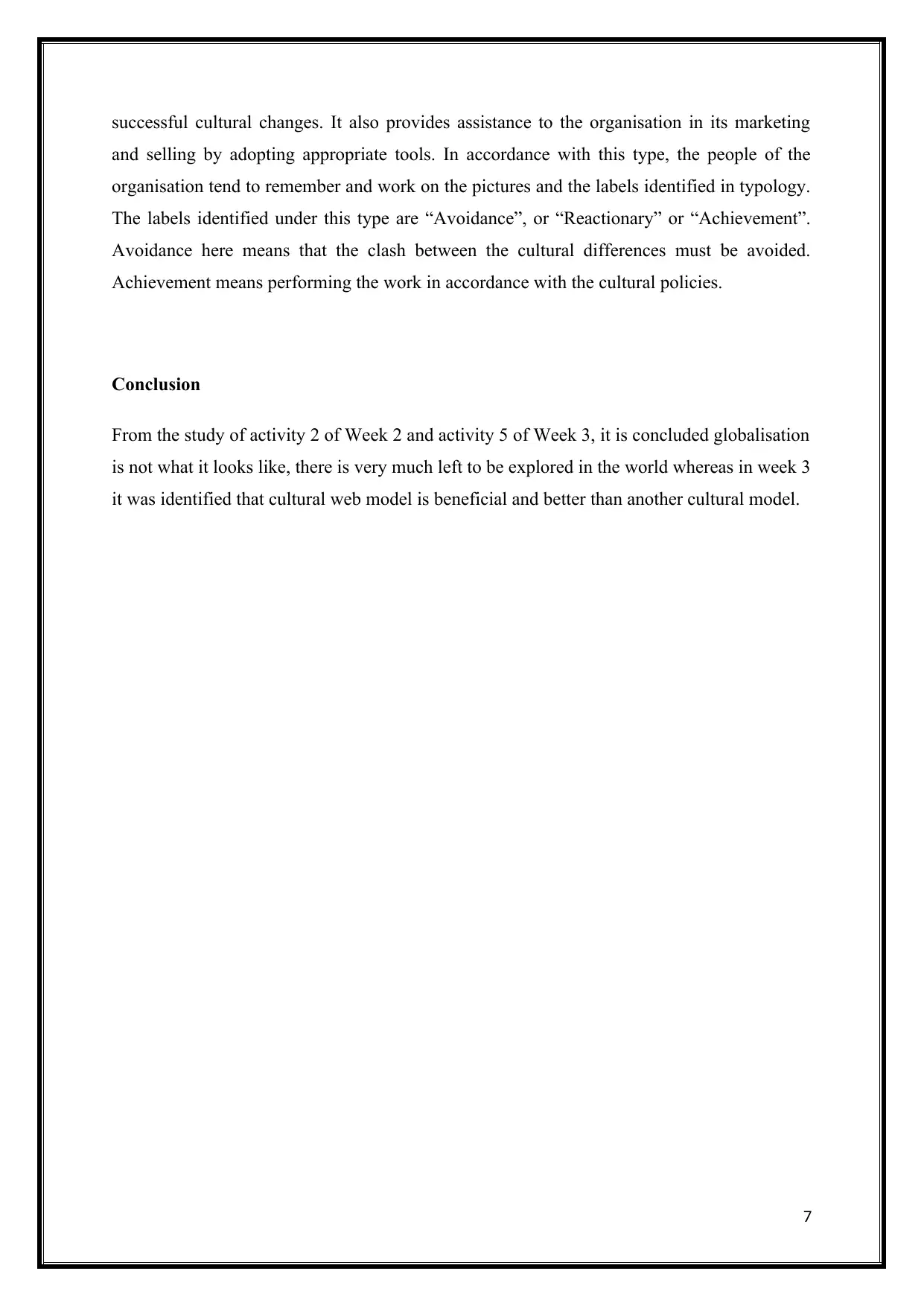
successful cultural changes. It also provides assistance to the organisation in its marketing
and selling by adopting appropriate tools. In accordance with this type, the people of the
organisation tend to remember and work on the pictures and the labels identified in typology.
The labels identified under this type are “Avoidance”, or “Reactionary” or “Achievement”.
Avoidance here means that the clash between the cultural differences must be avoided.
Achievement means performing the work in accordance with the cultural policies.
Conclusion
From the study of activity 2 of Week 2 and activity 5 of Week 3, it is concluded globalisation
is not what it looks like, there is very much left to be explored in the world whereas in week 3
it was identified that cultural web model is beneficial and better than another cultural model.
7
and selling by adopting appropriate tools. In accordance with this type, the people of the
organisation tend to remember and work on the pictures and the labels identified in typology.
The labels identified under this type are “Avoidance”, or “Reactionary” or “Achievement”.
Avoidance here means that the clash between the cultural differences must be avoided.
Achievement means performing the work in accordance with the cultural policies.
Conclusion
From the study of activity 2 of Week 2 and activity 5 of Week 3, it is concluded globalisation
is not what it looks like, there is very much left to be explored in the world whereas in week 3
it was identified that cultural web model is beneficial and better than another cultural model.
7
Paraphrase This Document
Need a fresh take? Get an instant paraphrase of this document with our AI Paraphraser
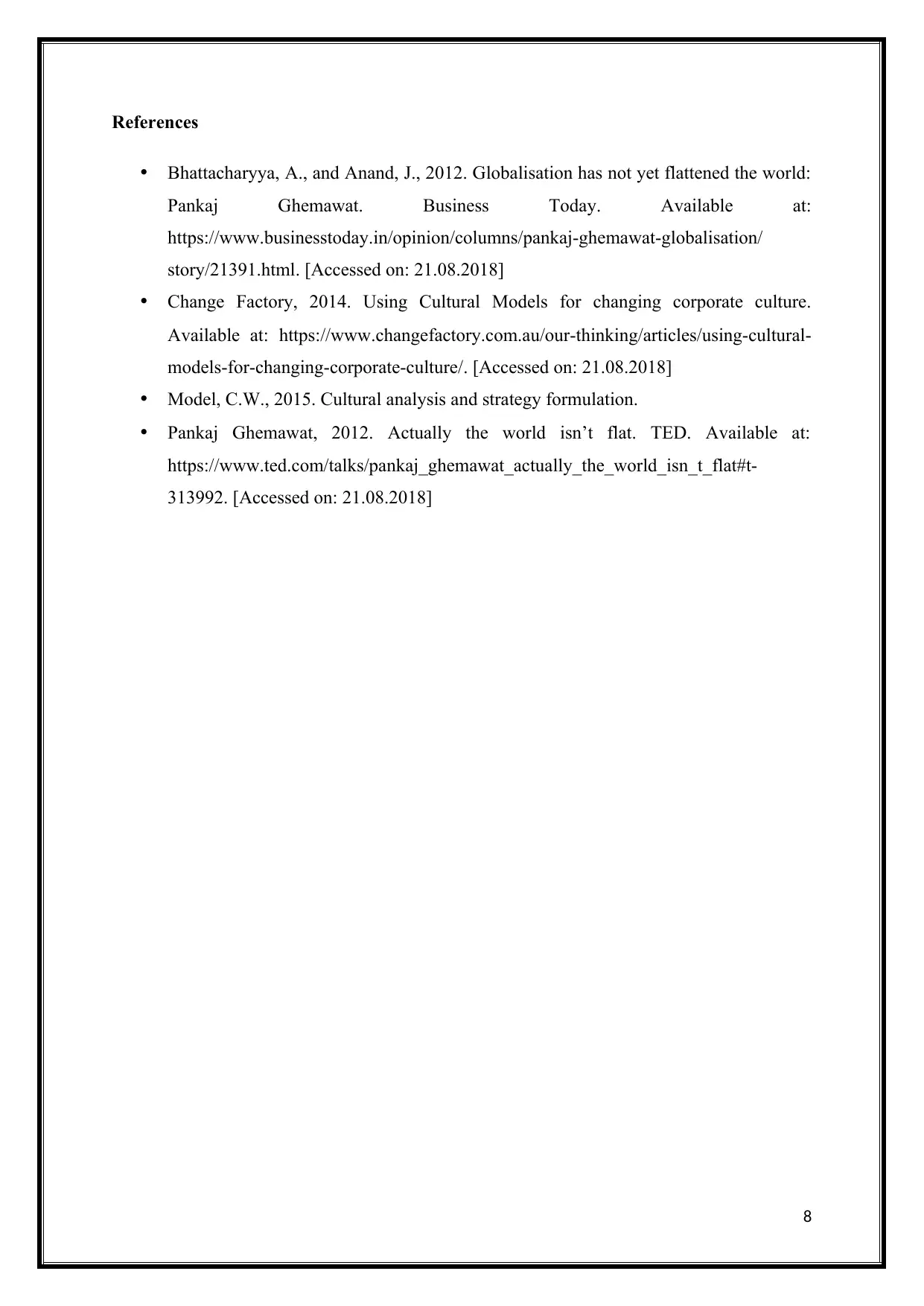
References
Bhattacharyya, A., and Anand, J., 2012. Globalisation has not yet flattened the world:
Pankaj Ghemawat. Business Today. Available at:
https://www.businesstoday.in/opinion/columns/pankaj-ghemawat-globalisation/
story/21391.html. [Accessed on: 21.08.2018]
Change Factory, 2014. Using Cultural Models for changing corporate culture.
Available at: https://www.changefactory.com.au/our-thinking/articles/using-cultural-
models-for-changing-corporate-culture/. [Accessed on: 21.08.2018]
Model, C.W., 2015. Cultural analysis and strategy formulation.
Pankaj Ghemawat, 2012. Actually the world isn’t flat. TED. Available at:
https://www.ted.com/talks/pankaj_ghemawat_actually_the_world_isn_t_flat#t-
313992. [Accessed on: 21.08.2018]
8
Bhattacharyya, A., and Anand, J., 2012. Globalisation has not yet flattened the world:
Pankaj Ghemawat. Business Today. Available at:
https://www.businesstoday.in/opinion/columns/pankaj-ghemawat-globalisation/
story/21391.html. [Accessed on: 21.08.2018]
Change Factory, 2014. Using Cultural Models for changing corporate culture.
Available at: https://www.changefactory.com.au/our-thinking/articles/using-cultural-
models-for-changing-corporate-culture/. [Accessed on: 21.08.2018]
Model, C.W., 2015. Cultural analysis and strategy formulation.
Pankaj Ghemawat, 2012. Actually the world isn’t flat. TED. Available at:
https://www.ted.com/talks/pankaj_ghemawat_actually_the_world_isn_t_flat#t-
313992. [Accessed on: 21.08.2018]
8
1 out of 8
Related Documents
Your All-in-One AI-Powered Toolkit for Academic Success.
+13062052269
info@desklib.com
Available 24*7 on WhatsApp / Email
![[object Object]](/_next/static/media/star-bottom.7253800d.svg)
Unlock your academic potential
Copyright © 2020–2025 A2Z Services. All Rights Reserved. Developed and managed by ZUCOL.





